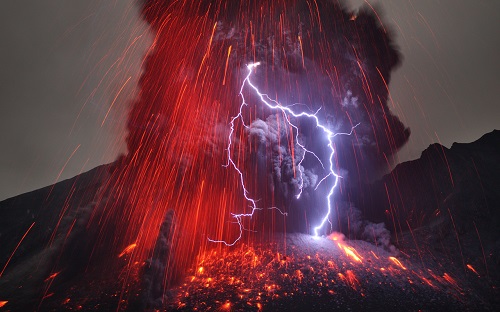BIG DATA
In wake of Hurricane Sandy, Oklahoma tornadoes, NSF awards $32 million in hazards sustainability grants

Scientists will study ways of predicting and responding to hurricanes, tornadoes, floods, earthquakes, tsunamis, wildfires
Sandy: the deadliest and most destructive hurricane of the 2012 Atlantic hurricane season and the second-costliest hurricane in U.S. history. Damage estimates from the storm surpass $68 billion, a total exceeded only by Hurricane Katrina in 2005.
With Sandy's one-year anniversary--October 29th--on the horizon, how do scientists better predict and respond to natural hazards such as hurricanes, tornadoes, floods, earthquakes, tsunamis and wildfires?
To find answers, the National Science Foundation (NSF) recently awarded 12 new grants totaling $32 million through its Interdisciplinary Research in Hazards and Disasters solicitation. The effort is part of NSF's Science, Engineering and Education for Sustainability (SEES) investment.
Hazards SEES is funded by several NSF directorates: Geosciences; Engineering; Social, Economic and Behavioral Sciences; Mathematical and Physical Sciences; and Computer and Information Science and Engineering.
The awards will advance understanding of natural hazards and of technological hazards linked with natural phenomena. They will also improve capabilities for predicting these hazards, mitigating their effects and enhancing the capacity to respond to and recover from natural disasters.
Hazards SEES projects cross the boundaries of the atmospheric and geospace, earth and ocean sciences; computer and information science; cyberinfrastructure; engineering; mathematics and statistics; and social, economic and behavioral sciences.
"Through the Hazards SEES program, NSF has made investments in research that will reduce the impact of natural hazards, enhance safety, and contribute to sustainability," says Roger Wakimoto, NSF assistant director for Geosciences.
"When we face such impending disasters as Hurricane Sandy or the Oklahoma tornadoes, it's critical that we have already developed ways of responding to and recovering from such devastating events."
Hazards SEES scientists and engineers will conduct research on such topics as the integration of natural, human and infrastructure systems for hurricane evacuation and sheltering; volcanic crises in the United States: from precursors to resilience; next-generation warning systems for tornadoes and flash floods; and magnitude 9 earthquake scenarios: modeling, warnings and response and resilience in the Pacific Northwest.
Other projects include predicting landslide hazards; promoting regional resilience to repeated heat waves and hurricanes; preventing flood hazards from becoming disasters through communication of parcel-level flood risk; and developing monitoring, prediction and resilience cyberinfrastructure for wildfires.
"We hope to find new ways of 'beating the storm,'" says Wakimoto, "in whatever form it may arrive."
2013 Hazards SEES Awards
Hazards SEES Type 2: WIFIRE: A scalable data-driven monitoring, dynamic prediction and resilience cyberinfrastructure for wildfires: Ilkay Altintas, University of California San Diego
Additional Collaborators: Michael Gollner, University of Maryland College Park
Hazards SEES Type 1: End-to-end development of time-dependent geo-targeted alerts and warnings enabled by dense observations of the 2011 Tohoku tsunami: Jean-Paul Ampuero, California Institute of Technology
Additional Collaborators: Jeannette Sutton, U. of Colorado, Colorado Springs
Hazards SEES Type 2: From sensors to tweeters: A sustainable sociotechnical approach for detecting, mitigating, and building resilience to hazards: Louise Comfort, University of Pittsburgh
Additional Collaborators: Kathleen Carley, Carnegie Mellon University; Emile Okal, Northwestern University; Lee Freitag, Woods Hole Oceanographic Institution
Hazards SEES Type 2: Dynamic integration of natural, human, and infrastructure systems for hurricane evacuation and sheltering: Rachel Davidson, University of Delaware
Additional Collaborators: Linda Nozick, Cornell University; Brian Colle, Stony Brook University/SUNY; Brian Blanton, University of North Carolina Chapel Hill; Randall Kolar, University of Oklahoma
Hazard SEES Type 1: Real-time geospatial infrastructure modeling for disaster response and rapid recovery: Craig Glennie, University of Houston
Hazards SEES Type 2: In hot water and harm's way: Modeling to promote regional resilience to repeated heat waves and hurricanes: Seth Guikema, Johns Hopkins University
Additional Collaborators: Celso Ferreira, George Mason University; Robin Dillon-Merrill, Georgetown University; Katie O'Meara, Maryland Institute College of Art; Margaret Walls, Resources for the Future Inc.
Hazards SEES Type 1: Persistent volcanic crises in the USA: From precursors to resilience: Bruce Houghton, University of Hawaii
Additional Collaborators: Robert Wolpert, Duke University; M. J. Bayarri, Marquette University; Michael Lindell, Texas A&M University; Greg Valentine, University of Buffalo; Michael Manga, University of California Berkeley
Hazards SEES Type 2: Hazard prediction and communication dynamics in the modern information environment: Rebecca Morss, National Center for Atmospheric Research
Additional Collaborators: C. Michael Barton, Arizona State University; Leysia Palen, University of Colorado Boulder
Hazard SEES Type 2: Next generation, resilient warning systems for tornadoes and flash floods: Brenda Philips, University of Massachusetts Amherst
Additional Collaborators: V. Chandrasekar, Colorado State University; Joseph Trainor, University of Delaware
Hazards SEES Type 2: Preventing flood hazards from becoming disasters through two-way communication of parcel-level flood risk: Brett Sanders, University of California Irvine
Additional Collaborators: Edmund Balsdon, San Diego State University; Kristen Goodrich, Southwest Wetlands Interpretive Association
Hazards SEES Type 1: Predicting landslide runout and granular flow hazard: enhanced-g centrifuge experiments, contact dynamics model development and theoretical study: Colin Stark, Columbia University
Hazards SEES Type 2: Magnitude 9 earthquake scenarios--probabilistic modeling, warnings, response and resilience in the Pacific Northwest: John Vidale, University of Washington

